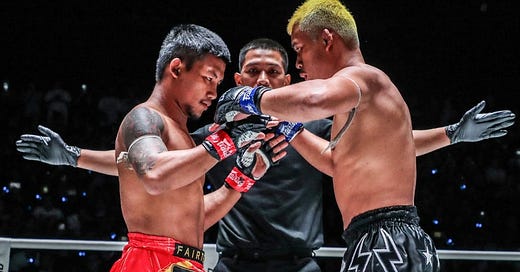Four-Ounce Muay Thai: Evolution or Spectacle? (Part 1)
A short explanation on current and potential trajectories with 4 oz. muay Thai fights. This is a response to the rise of ONE Championship and North American Boonchu fights.
Four-ounce gloves and muay Thai is not a new phenomenon, John Wayne Parr should be the one properly credited for introducing the style with his Caged Muay Thai promotion. However, when you have as many hedge fund connections as Chatri Sityodtong, it is very easy to craft a narrative around your promotion and the sport that is both false and borderline unscientific. Based on the contracts being received by ONE Championship fighters, make no mistake that is an organization that has no intention of taking care of any fighters (let alone muay Thai fighters) and that is why would like to start this piece off with shutting down these assumptions about the “rise” of four-ounce muay Thai.
In reality, what is happening is that Chatri Sityodtong and the executives at ONE Championship have figured out that the Western muay Thai fan is fundamentally the same as the Western UFC fan, except with a far more orientalist tinge as to why they are obsessed with “beating the Thais” in a sport that is closer to early MMA than it is to elite muay Thai. Westerners are politically, ideologically, and psychologically, to view blood, pain, and damage, as the sign of a good fight and not a consequence of using less equipment while the referees and rules of the sport brazenly encourage poor defense. In other words, in order to properly analyze four-ounce muay Thai, we cannot invent false realities about why it exists and why it is being promoted to us as the “new wave” despite the mass of fighters increasingly getting worse due to poor training development being led by people who have held their positions for far too long because many high-ranking people in these sports still think it is 2012.
Rather than give you the same story about why four-ounce muay Thai is so uniquely different from “traditional” muay Thai, I hope to implore those who read this to trust in the style they bring to the sport and avoid becoming a practitioner who latches onto everything shiny and new because it went viral on Instagram. Here are some important considerations that need to be taken into account when discussing, training, and strategizing for four-ounce muay Thai fights.
Accept that you are no longer operating under the conditions of a normal muay Thai fight. Four-ounce muay Thai is a blend of a entertainment muay Thai and amateur MMA. The conditions do not inherently benefit the slick stadium fighter but this does not mean they cannot succeed/dominate, they simply must adapt.
The boxer-puncher has an advantage that should be acknowledged but not feared, instead we must game-plan and prepare ourselves through rigorous study and sparring scenarios that mimic the scenario of the fight. This might also include finding a local gym that has a cage to get used to the differences between space in a ring versus in a cage.
Some boxing experts argue that a large portion of the reason why old-school boxers were so successful was because their base was “bare-knuckle pugilism.” Muay Thai practitioners and coaches must also engage in a deep dive on the history of their sport (including the invention of the myths surrounding it) to understand and learn older, simpler techniques that took into the account the reality of small gloves and/or no gloves.
The clinch is going to be an flexible factor in the evolution of four-ounce muay Thai. If more money and investment goes towards getting a Western audience attracted to muay Thai, fighters who have a muay Khao/clincher style need to recognize that four-ounce gloves are designed for their needs and will allow them to take advantage of the same strategies that have led to the high-rate of success of wrestlers (or strikers with a WRESTLING background) at the highest levels of mixed martial arts. Those who can control time by striking and space by grappling have historically dominated many combat sports.
If four-ounce muay Thai grows, we could potentially witness the evolution of fighters who will finally abandon the old-model (forced upon us by too many people listening to Joe Rogan and the Gracie cult) of mediocre striking with an emphasis on BJJ grappling that they don’t even use effectively in the cage. Muay Thai with four-ounce gloves and wrestling are two arts that blend together as much as boxing and wrestling while having an upper body clinching component that is far more important to learn for modern MMA than a new jiu-jitsu guard system. Muay Thai has all the tools it needs to be successful within any sport where striking & grappling exists, but our sport needs coaches like Abdulmanap Nurmagomedov, Ray Arcel, and George Benton who are able to recognize the conditions and the evolution of their sport while still producing successful fighters that have old-school and effective fundamentals of how to strike, how to defend, and how to grapple.




